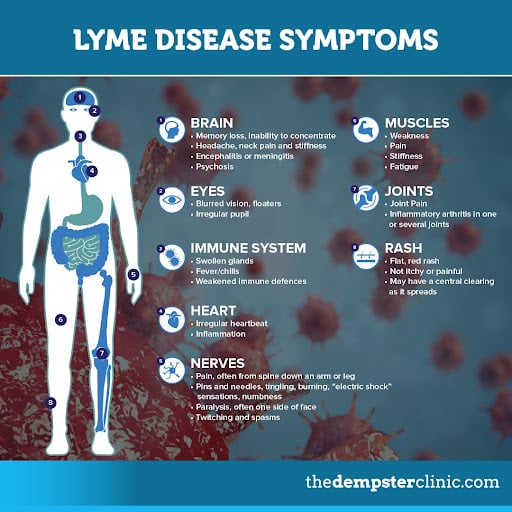As long as we wish to be surrounded by nature and trees, we have to accept the possibility of tick bites and tickborne diseases. And even though many are harmless and cause no noticeable symptoms, there are bacteria, like Borrelia burgdorferi that transmit serious diseases like Lyme disease.
Lyme disease – the most commonly transmitted tick-borne infection in North America – wasn’t recognized as a medical condition until very recently, just some 40-45 years ago! This is even more surprising considering that the bacteria causing Lyme disease has been lurking around for thousands of years. Excavation of a 5,300 year-old mummy, called an “Iceman”, confirmed that our ancestors also suffered from B. burgdorferi and possibly even Lyme disease.
But it wasn’t until the 1960-70s when Lyme disease gained public attention after children in Lyme, Connecticut started having unexplainable symptoms like fatigue, skin rashes, fever, arthritis, etc. If it wasn’t for two persistent mothers who pushed the Connecticut State Department of Health to look into this outbreak, we might have still been oblivious to this serious medical condition.
THREE STAGES OF LYME DISEASE: COMMON SYMPTOMS

Lyme disease can be divided into three stages based on symptoms: early localized, early disseminated and late.
Early localized stage includes symptoms like red growing rash, flu-like symptoms, headache, fatigue, fever, muscle pain, neck stiffness and joint stiffness. These are the most common symptoms that people with Lyme disease experience. A person can develop these symptoms within 1-28 days after the tick bite.
Early disseminated disease includes large rash (erythema migrans) which tends to expand, as well as swelling of lymph nodes, joint pain, palsy of cranial nerves and eye pain. It can even manifest itself as heart-related problems, like myocarditis or pericarditis. Stage 2 disease develops between 3-12 weeks after the bite.
Late disease includes symptoms like arthritis, which mostly affects large joints like knees. Late Lyme disease can take months or years to develop, so by the time a patient gets symptoms, they might not even remember about their encounter with ticks.
Symptoms aren’t uniform across people and depend on the stage of Lyme disease. Also, it’s important to note that Lyme disease symptoms in children are very similar to those in adults. Major clinical manifestations appear on skin, central nervous system, joints and heart.
IS CHRONIC LYME DISEASE REAL?
Few decades ago people debated about Lyme disease. Today, when Lyme disease is an official condition, we see a lot of debate about something called Chronic Lyme Disease (CLD). So, is it a real thing? Let me shed some light on this topic.
Advocacy groups including physicians and naturopathic doctors have been pushing hard to define chronic Lyme disease and support patients with painful lifelong symptoms. But many researchers have been rejecting the existence of chronic Lyme Disease for years. They said that it was a poorly defined term that was not a real diagnosis. One of the criticisms was that the definition of Chronic Lyme Disease didn’t even mention the Borrelia burgdorferi – a bacteria that causes the actual Lyme disease. So, without a definition it was practically impossible to study, discuss or diagnose CLD.
Another criticism was that the symptoms attributed to CLD were too broad and could be ascribed to many other medical conditions. For example, something diagnosed as Chronic Lyme Disease, could in reality be a neurologic or rheumatologic disease.
Following all the criticism, International Lyme and Associated Diseases Society (ILADS) reviewed over 250 peer-reviewed studies and officially defined chronic Lyme disease. This was an important step in better understanding and diagnosing CLD.
According to ILADS’ definition, CLD can emerge due to diagnostic delays or failed antibiotic therapy among other things and it’s an illness that reappears or is continuously present for at least 6 months (similar to other chronic infections). It can be classified into two groups: untreated (CLD-U) and previously treated (CLD-PD) which have different symptoms and need respective treatments.
Some doctors still don’t acknowledge the CLD, which means that many patients are potentially misdiagnosed or go untreated and continue experiencing lifelong pain and suffering.

The problem is exacerbated by insurance companies which side with organizations that say that CLD is NOT a real thing. Without proper diagnosis, these patients remain perpetually sick, lose quality of life and potentially cost the healthcare system more frustration, resources, and ultimately more money over time.
LYME DISEASE TESTING
If you were bitten by a tick or are experiencing symptoms like rash, flu-like symptoms, headache, fatigue, fever, muscle pain, neck stiffness and joint stiffness you should definitely consider testing for Lyme disease. Lyme disease can lead to chronic inflammation, which has a huge effect on the body.
At the Dempster Clinic we discuss several tests for a diagnosis of Lyme disease. These include direct and indirect tests:
Indirect tests look for the patient’s immune response to B. burgdorferi.
Direct tests look for the presence of B. burgdorferi antigens or nucleic acids. This test involves a blood sample that is sent to a lab for accurate analysis and results are sent to the clinic.
LYME DISEASE TREATMENT
In case of confirmed Lyme disease or chronic inflammation, we offer intravenous vitamin therapy which has been helpful to many Lyme sufferers as an adjunctive treatment.. One of the biggest advantages of this therapy is that the nutrients enter the bloodstream more quickly and effectively than oral supplementation, thus providing an impactful strategy to deal with the many systemic fallouts of Lyme disease.
You can read more about IV Vitamin therapy that we offer at the clinic here.
High-dose Vitamin C is a popular type of IV therapy, as it can be helpful in eliminating pathogens and even possibly providing support for those with chronic disease It also reduces toxicity levels in the body, supports immunity, and reduces CRP and pro-inflammatory cytokines in the body. At The Dempster Clinic, we are proud to offer a wide range IV Vitamin therapy treatments to our patients.
Another procedure that helps patients with Lyme disease (as well as other health conditions like Multiple Sclerosis, Parkinson’s disease and aging in general) is Glutathione IV. It restores your glutathione levels which are crucial for people with infections. Many regularly prescribed pharmaceutical medications have also been known to deplete glutathione pools in your body, especially affecting your liver and critical detoxification processes.
If you are interested in learning more about Lyme disease diagnosing and treatment, then I encourage you to schedule an appointment at my clinic. At The Dempster Clinic – Center for Functional Medicine, I will partner with you to analyse your specific needs and address any other health concerns.
Please take advantage of my Complimentary 15-minute Discovery Session, which is available for all prospective patients. This session can take place over the phone or at the clinic in person. It gives you a chance to learn more about the services I offer and how they can help you find your best health.

